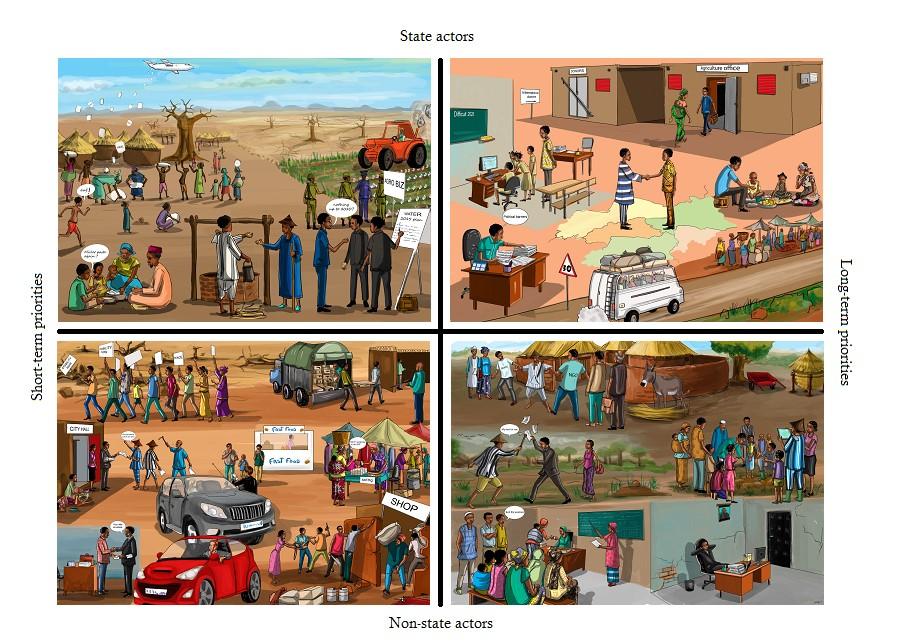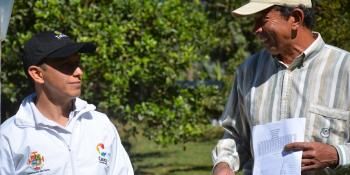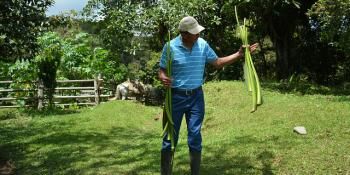Planning under uncertainty: the development of socio-economic scenarios for West Africa

Researchers and West African stakeholders map out four possible future scenarios for the region.
Since 2010, the CGIAR Research Program on Climate Change, Agriculture and Food Security (CCAFS) has been collaborating with a wide range of actors from West Africa with the aim of developing socio-economic scenarios for the region. The CCAFS scenarios team has organized a series of workshops where regional stakeholders outlined the major drivers of change in the region, resulting in four different future scenarios for West Africa. These are structured along two main axes of uncertainty: (1) whether governments and other actors focus on short-term or long-term priorities; and (2) whether state or non-state actors are driving change within the region. Four scenario narratives were produced, representing very different plausible futures. The scenarios were visualized by cartoonist André Daniel Tapsoba (see below) and the regional stakeholders named them:
- Cash, Control & Calories (upper left) is about short-term priorities with state actors as the dominant force in West Africa to 2050
- Self-determination (upper right) is a scenario where state actors are dominant and long-term priorities prevail
- Civil Society to the Rescue? (lower right) is a scenario where non-state actors are dominant and long-term issues have priority
- Save Yourself (lower left) is a scenario where non-state actors are the driving force and short-term priorities dominate

Artistic representation of the West Africa scenarios. Artist: André Daniel Tapsoba
After developing these qualitative scenario narratives, stakeholders made a semi-quantitative assessment of key indicators for each of the four scenarios. The scenarios were then linked to the Intergovernmental Panel on Climate Change (IPCC) global Shared Socio-economic Pathways (SSPs) and quantified using two agricultural economic models: (1) GLOBIOM, developed at the International Institute for Applied Systems Analysis (IIASA), and (2) IMPACT, developed at the International Food Policy Research Institute (IFPRI).
A newly available working paper, 'The future of food security, environments and livelihoods in Western Africa: Four socio-economic scenarios,' describes the process of developing these socio-economic scenarios for West Africa, as well as provides details on the scenarios themselves and their implications for policy. The scenarios represent different futures of food security, environments and (rural) livelihoods providing challenging contexts for regional, national, and sub-national decision makers to test policies and plans and make them more robust in the face of future uncertainty. The CCAFS West Africa scenarios have been used in a number of policy design processes to date, including ECOWAS priority setting, reviewing the National Plan for the Rural Sector for Burkina Faso (PNSR), and district and national level policy processes in Ghana.
Download the working paper:
Palazzo A, Rutting L, Zougmoré R, Vervoort JM, Havlik P, Jalloh A, Aubee E, Helfgott AES, Mason-D’Croz D, Islam S, Ericksen PJ, Segda Z, Moussa AS, Bayala J, Kadi Kadi HA, Sibiry Traoré PC, Thornton PK. 2016. The future of food security, environments and livelihoods in Western Africa: Four socio-economic scenarios. CCAFS Working Paper no. 130. Copenhagen, Denmark: CGIAR Research Program on Climate Change, Agriculture and Food Security (CCAFS).
Read more about the future scenarios approach:
Scaling out scenario-guided policy and investment planning
Lucas Rutting is a Scenarios and Policy researcher with CCAFS and the Environmental Change Institute at University of Oxford. He coordinates the CCAFS scenarios work in East and West Africa.




